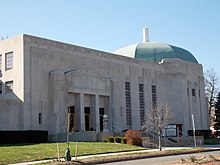Nineteenth Street Baptist Church (Washington, D.C.)
| Nineteenth Street Baptist Church | |
|---|---|

Nineteenth Street Baptist Church
|
|
| Basic information | |
| Location | 4606 16th Street N.W.. Washington, D.C. 20011 |
| Geographic coordinates | 38°56′48.5″N 77°2′12.5″W / 38.946806°N 77.036806°WCoordinates: 38°56′48.5″N 77°2′12.5″W / 38.946806°N 77.036806°W |
| Affiliation | Baptist |
| Country | United States of America |
| Status | Active |
| Leadership | Dr. Darryl D. Roberts, Senior Pastor |
| Website | Nineteenth Street Baptist Church |
| Architectural description | |
| Architect(s) | Brandt, Waronoff and Westric |
| Architectural style | Art Deco |
| Materials | Alabama limestone |
The Nineteenth Street Baptist Church, located on 16th Street, NW, is considered to be the first and oldest black Baptist congregation in Washington, D.C. Since its founding in 1839, the church has figured prominently within the historical and social fabric of Washington, D.C.'s African American community.
Established as the First Colored Baptist Church of Washington, D.C. on August 29, 1839, the congregation finds its earliest beginings within The First Baptist Church of the City of Washington, DC which was founded on March 7, 1802. Described initially as an interracial congregation, black members worshipped alongside whites. However, similar to other congregations of the time, the church gradually began to segregate its black members from white parishioners. Given their discontent with being assigned to the gallery of what was now the new location of the First Baptist Church, in 1833 a majority of the black members chose to return to the original site located at 19th and I Streets, N.W. The black members of the First Baptist Church continued to worship under the authority of the parent church at the 19th and I Streets location until 1839 when they expressed interest in being organized as a separate body. This request was refused by First Baptist Church. Reverend Sampson White, who was also instrumental in the establishment of the Abyssinian Baptist Church of New York City, would play an integral role in the founding of the independent congregation.
Sampson White, who had begun to organize a smaller group of black worshipers not from the First Baptist Church, secured recognition from leading white and black Baptists of Baltimore to establish a church. The original members of White's group included his wife, William Bush, Eliza Bush, Lavinia Perry and Emily Coke. With recognition secured, Sampson White's small group received into their body all of the black members of the First Baptist Church currently worshipping at the 19th and I Streets location. With the addition of these members, the membership swelled to a number ten times the size of White's original group. With the new members being in possession of the property at 19th and I Streets--an assertion that would be challenged for some years--the First Colored Baptist Church of Washington, D.C. was established in 1839 with Sampson White serving as its first pastor.
The congregation eventually purchased the property on the southwest corner of 19th and I Streets, N.W. Soon after its founding, the church was admitted to the Philadelphia Baptist Association in October 1840. From 1839 to 1882, the church experienced rapid development including the organization of a Board of Deacons, a Board of Trustees, the Missionary Society, the Christian Mite Society, the Senior Choir, the Sunday School and the formulation of the church's Rules of Decorum. In 1867, the American Baptist Home Mission Society used the basement of the church to offer courses to freedmen interested in entering the Baptist ministry. The program would eventually become the Wayland Seminary. On November 16, 1870 the church received its charter and was incorporated as the Nineteenth Street Baptist Church. A new edifice would be erected in 1871 and serve as the worship site for over a century.
...
Wikipedia
